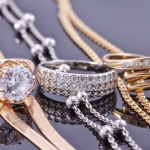Intro: Spotting Fake Gold and Silver
To spot fake gold and silver, check for non-magnetic properties and consistent hallmarks like "24K" or "925.” Then, use simple tests, such as the scratch test for gold or the ice cube test for silver, to confirm authenticity.
There are numerous ways to determine the authenticity of precious metals. Trained experts, like the team at Gold Rush, utilize highly refined techniques and specialty technology to assess their purity. Gold Rush is a dedicated gold and silver buyer. We buy all precious metals and diamonds, with the most competitive offers passed on weight, purity, and market price.
Come by for the best gold and silver knowledge around!
What Are Fake Gold and Silver?
Fake gold and silver are imitations designed to mimic the appearance of genuine metals. These include gold-plated, gold-filled, and silver-plated items that use a thin layer of precious metal over a base metal.
While they may look convincing, these materials are less valuable and durable.
Their true composition often includes inexpensive metals such as copper, nickel, or brass. Recognizing these differences helps buyers avoid counterfeit products.
Key Characteristics of Genuine Gold and Silver
Genuine gold and silver exhibit distinct physical and chemical properties.
Real gold has a warm yellow hue, significant weight, and resists tarnishing.
Real silver, known for its bright white appearance, tarnishes naturally but maintains its value and strength.
Counterfeit metals often fade, feel lighter, or corrode over time.
Comparison Table: Genuine vs. Counterfeit Metals
Simple At-Home Tests for Spotting Fake Metals
The Magnet Test
Gold and silver are not magnetic. If your item is attracted to a magnet, it likely contains base metals rather than genuine gold or silver.
The Scratch Test
Rub your gold on a ceramic plate or tile. Real gold leaves a golden streak, while fake gold produces a black mark. For silver, look for a consistent shine without flaking.
The Float Test
Place your item in water. Genuine gold will sink due to its density. Counterfeit pieces may float or suspend.
Skin Discoloration Test
Wearing fake metals can leave green or black marks on your skin due to reactions with moisture or oils. Authentic gold and silver will not cause discoloration.
Advanced Methods for Authenticating Gold and Silver
Professional testing methods provide precise and reliable results for identifying genuine gold and silver.
Jewelers and appraisers widely use these techniques to confirm metal purity and composition.
-
Acid Test: A drop of acid applied to a small scratch on the metal determines purity based on color changes.
-
Electronic Testers: Devices that measure electrical conductivity to assess the metal’s gold or silver content.
-
X-ray Spectrometry: Non-destructive X-rays analyze the exact composition, including percentages of gold or silver.
Typical Hallmarks and Stamps to Identify Authenticity
Hallmarks are a reliable way to confirm gold and silver authenticity.
For gold, common hallmarks include "24K" (99.9% gold), "18K" (75% gold), and "999" for near-pure gold bullion.
Silver often bears "925" for sterling silver or "999" for fine silver.
These stamps indicate composition and are usually found on clasps or inconspicuous areas.
Misleading markings such as "HGP" (heavy gold plate), "GP" (gold-plated), or "GF" (gold-filled) signal lower-quality items. Silver-plated items may lack hallmarks or have different identifiers distinguishing them from genuine silver.
Buying Tips to Avoid Counterfeit Metals
Avoiding counterfeit gold and silver requires vigilance and informed decision-making.
Look for clear certifications and professional appraisals when purchasing high-value items.
-
Always request certifications.
-
Shop from reputable dealers with strong reviews.
-
Verify return policies to safeguard your purchase.
-
Compare pricing against market standards for consistency.
-
Utilize appraisers to confirm authenticity before completing transactions.
FAQ: Identifying Real Gold and Silver
How do you test for fake gold?
Fake gold can be identified with simple tests like the magnet test (real gold is non-magnetic), the scratch test (real gold leaves a gold streak on ceramic), or the float test (real gold sinks in water). Professional methods include acid testing, electronic conductivity testing, and X-ray analysis.
How to identify real gold at home?
You can use the magnet, float, or scratch tests to identify real gold. Check for hallmarks like “24K” or “18K” on jewelry and look for consistent color without tarnish or discoloration.
How can you tell if something is gold or gold-plated?
Gold-plated items may have markings like “GP” or “HGP” and feel lighter than genuine gold. Scratching the surface can reveal a base metal underneath. Professional acid testing can confirm if it’s plated.
How can you tell real silver from fake?
Real silver is non-magnetic, tarnishes naturally, and often has hallmarks like “925” or “999.” The ice cube test is another method—real silver will quickly melt ice due to its high thermal conductivity.
What is the quick test for silver?
The magnet and ice cube tests are quick ways to identify silver. If the item isn’t attracted to a magnet and ice melts rapidly on its surface, it’s likely real silver.
Can you test real silver with vinegar?
Yes, vinegar can be used to test silver. Apply a small drop of vinegar to the surface; if the metal changes color or reacts, it’s likely not real silver. Be cautious, as vinegar can tarnish silver.
Conclusion: Protecting Your Investment with Confidence
Knowing how to spot counterfeit precious metals can be an advantageous skill. These tips can be especially helpful if you buy or sometimes sell jewelry or coins.
If you would instead leave it up to the experts, the distinguished team at Gold Rush Denver and Gold Rush Houston are here for you. We are dedicated to providing our clients with the best gold-selling experience possible - and that begins with a transparent and informative valuation.
If you want to sell gold in Colorado or Texas, Gold Rush is waiting to help!








